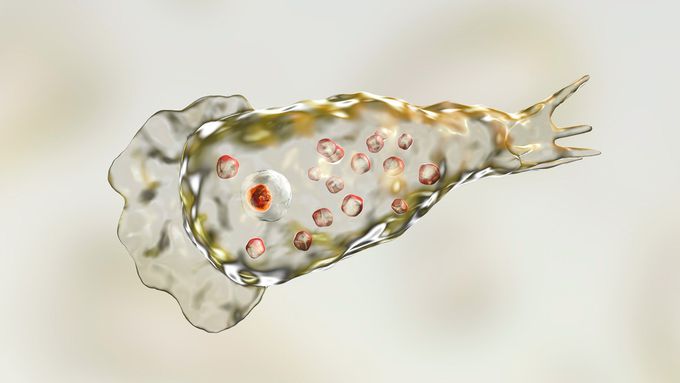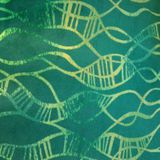


BRAIN-EATING AMOEBA OR NAEGLERIA FOWLERI
What Is a Brain-Eating Amoeba? Amoebas are single-celled organisms. The so-called brain-eating amoeba is a species discovered in 1965. It's formal name is Naegleria fowleri. Although first identified in Australia, this amoeba is believed to have evolved in the U.S. There are several species of Naegleria but only the fowleri species causes human disease. There are several fowleri subtypes. All are believed equally dangerous. N. fowleri is microscopic: 8 micrometers to 15 micrometers in size, depending on its life stage and environment. By comparison, a hair is 40 to 50 micrometers wide. Like other amoebas, Naegleria reproduces by cell division. When conditions aren't right, the amoebas become inactive cysts. When conditions are favorable, the cysts turn into trophozoites -- the feeding form of the amoeba. Where Are Brain-Eating Amoebas Found? Naegleria loves very warm water. It can survive in water as hot as 113 degrees Fahrenheit. These amoebas can be found in warm places around the globe. N. fowleri is found in: Warm lakes, ponds, and rock pits Mud puddles Warm, slow-flowing rivers, especially those with low water levels Untreated swimming pools and spas Untreated well water or untreated municipal water Hot springs and other geothermal water sources Thermally polluted water, such as runoff from power plants Aquariums Soil, including indoor dust Naegleria can't live in salt water. It can't survive in properly treated swimming pools or in properly treated municipal water. Most cases of N. fowleri disease occur in Southern or Southwestern states. Over half of all infections have been in Florida and Texas. How Do People Get Infected With Brain-Eating Amoeba? The term "brain-eating amoeba" makes the amoeba sound like a tiny zombie stalking your skull. But brains are accidental food for them. According to the CDC, N. fowleri normally eats bacteria. But when the amoeba gets into humans, it uses the brain as a food source. The nose is the pathway of the amoeba, so infection occurs most often from diving, water skiing, or performing water sports in which water is forced into the nose. But infections have occurred in people who dunked their heads in hot springs or who cleaned their nostrils with neti pots filled with untreated tap water. A person infected with N. fowleri cannot spread the infection to another person. How Do Amoebas Get in the Brain? Studies suggest that N. fowleri amoebas are attracted to the chemicals that nerve cells use to communicate with one another. Once in the nose, the amoebas travel through the olfactory nerve (the nerve connected with sense of smell) into the frontal lobe of the brain. How Frequently Do People Get Infected by a Brain-Eating Amoeba? Even though N. fowleri amoebas are relatively common, they only rarely cause brain disease. N. fowleri disease is known as primary amoebic meningoencephalitis (PAM). It occurs from zero to eight times a year, almost always from July to September. It's considered a rare infection. But some cases may be unreported. A study in Virginia that looked at more than 16,000 autopsy records from patients who died of meningitis found five previously unreported cases of PAM. Studies show that many people may have antibodies to N. fowleri. That suggests that they became infected with the amoeba but that their immune systems fought it off. It's not at all clear whether N. fowleri is a rare infection that always causes PAM and is almost always fatal, or a more common infection that only sometimes causes PAM. In a 2009 study, CDC researchers suggested that the common finding of antibodies to the amoeba in humans and the frequent finding of N. fowleri in U.S. waters indicates "that exposure to the amoeba is much more common than the incidence of PAM suggests." How Long Until Symptoms of a Brain-Eating Amoeba Appear? It takes two to 15 days for symptoms to appear after N. fowleri amoebas enter the nose. Death usually occurs three to seven days after symptoms appear. The average time to death is 5.3 days from symptom onset. Only a handful of patients worldwide have been reported to have survived an infection. What Are the First Symptoms Someone Might Have? Symptoms of PAM are not specific to this disease. At first, PAM may seem like viral meningitis. Symptoms include: headache fever stiff neck loss of appetite vomiting altered mental state seizures coma There may also be hallucinations, drooping eyelid, blurred vision, and loss of the sense of taste. Is There a Treatment for Infection With Brain-Eating Amoeba? The right treatment isn't clear. A number of drugs kill N. fowleri amoebas in the test tube. But even when treated with these drugs, very few patients survive. Is There a Rapid Test for Infection With Brain-Eating Amoeba? There is no rapid test for infection with brain-eating amoeba. But researchers are working to develop one. Until such tests come along, it can take weeks to identify the amoeba. How Do Amoebas Dissolve Brain Tissue? One study suggests that N. fowleri amoebas produce two proteases -- enzymes that dissolve protein. Are Certain Groups Affected More Than Others? Over 60% of U.S. cases are in children age 13 or younger. About 80% of cases are in males. It's not at all clear whether children or males are more susceptible to the amoeba, or whether young males are more likely to engage in activities that expose them to the amoeba. How Can I Protect Myself Against Brain-Eating Amoeba? It makes sense to avoid swimming underwater, diving, water skiing, and jumping in warm, still waters during the late summer. It also makes sense to wear a nose clip when swimming, boating, or playing in or on warm waters. It's also a good idea to avoid stirring up mud while taking part in such activities. And if you are cleansing your nostrils, be sure to fill your neti pot or squeeze bottle with distilled or sterile water -- not tap water. You can also use water that has been boiled for one minute (three minutes at high elevations) and then cooled. And you can filter the water using filters with pores no larger than 1 micron (1 micrometer).
Thank you for presenting the information and knowledge behind this dangerous amoeba, along with its picture.
Wow, the entire read was so interesting!! 🤘👩🎤 Especially liked the hair comparison, because I heard the figure before, but didn't really appreciate at how small it really was. Also the heat and the antibodies. One thing I learned is that ameboid form had vacuoles, and that its nucleus is kinda cool, like a fried egg.


